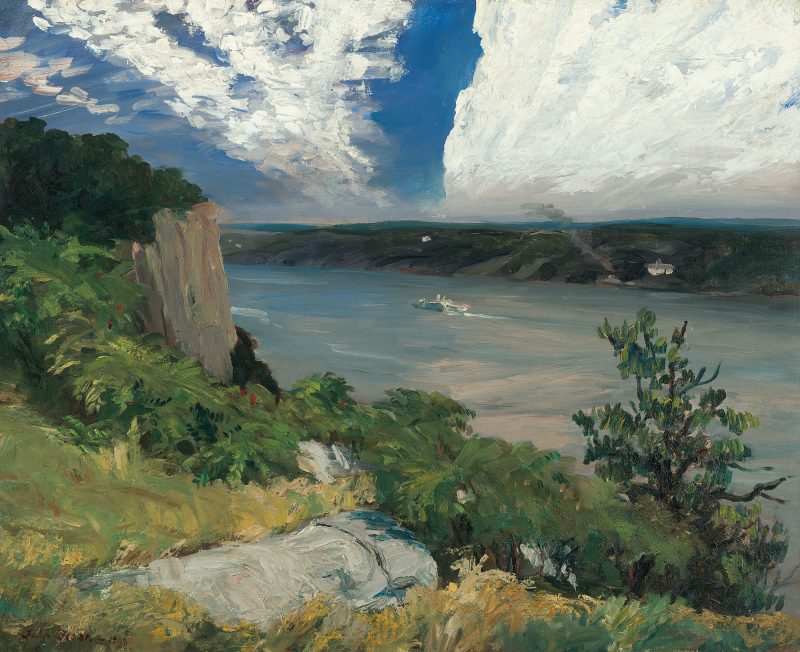
Hudson Sky
Sloan, John
1908
Artwork Information
-
Title:
Hudson Sky
-
Artist:
Sloan, John
-
Artist Bio:
American, 1871–1951
-
Date:
1908
-
Medium:
Oil on canvas
-
Dimensions:
26 1/8 x 32 1/4 in.
-
Credit Line:
Wichita Art Museum, Roland P. Murdock Collection
-
Object Number:
M5.39
-
Display:
Not Currently on Display
About the Artwork
Born in Lockhaven, Pennsylvania, John Sloan moved at an early age to Philadelphia, where he spent most of his early life. A self-taught illustrator and letterer, Sloan attempted a career as a freelance artist before the need for a more stable source of income led him to join the staff of the Philadelphia Inquirer in 1892. In 1895 Sloan moved to the Philadelphia Press, where he developed friendships with fellow staff illustrators William Glackens, George Luks, and Everett Shinn. In addition, Sloan enrolled in night classes under Thomas Anschutz at the Pennsylvania Academy of the Fine Arts, where he also met Robert Henri.
In 1904 Sloan, secure in his accomplishments and reputation as an illustrator, followed his Press colleagues to New York City, where he once again sought work as a freelance artist. Sloan found the New York cityscape and its inhabitants to be ideal subjects for his oil paintings, watercolors, and etchings. While these works were critically successful, the artist was continually disappointed by the slow sales of his new work. His peers at the National Academy of Design disparaged his work as well; selection committees at Academy exhibitions often hung his paintings in high corners or rejected them altogether. Following Henri in a boycott of the National Academy exhibition of 1907, Sloan and his Philadelphia colleagues, joined by Arthur B. Davies, Ernest Lawson, and Maurice Prendergast, held an independent exhibition at the Macbeth Galleries in February of 1908. Sloan played a major role in the organization of this exhibition of the group the critics dubbed “The Eight.”
In June of 1908, Sloan left New York for Coytesville, New Jersey. There, working on nine-by-eleven-inch canvases, he painted a series of landscapes on the Palisades. These were the first landscapes Sloan had painted outdoors in eighteen years. Most of them can be described as oil sketches of the atmospheric conditions prevailing over the Hudson River and distant Manhattan. In his diary entry of 16 June, Sloan wrote: “This morning the weather was clear, the sky filled with big clouds. I made a first sketch from the top of the Palisades looking down at an apron of ground.”1 Sloan wrote three days later, that “the cliffs below and New York across the river are limitless in the interesting effects of light and haze.”2 Hudson Sky was likely worked up from the oil sketch Sloan describes in his diary.
The large cloud formation and the cool blue of the sky dominate the painting. As the orthogonals of the cloud banks recede, a large wall of rock on the left bridges the division between the sky, the horizon line of the landscape, and the river, compositionally unifying the blues of the sky and water with the earth tones of the land. Sloan also echoes this unification through the steam of a distant ship across the river. Except for the receding clouds and the minimal use of atmospheric perspective, the artist seems unconcerned with establishing depth in his landscape, which reads as a flat surface. This surface flatness is accentuated by the activity of Sloan’s brushwork, particularly vibrant in the foliage of the Palisades. Thus, the painting maintains a delicate balance between the suggestion of illusionistic space and the indication of the artist s painterly performance. Hudson Sky and the other Palisades landscapes, in their inclination toward flatness and their emphasis on bold brush-work, predict the same qualities that are more pronounced in Sloan’s later, better-known Gloucester landscapes.
1. John Sloan, 16 June 1908, in Bruce St. John, ed., John Shan’s New York Scene: From the Diaries, Notes, and Correspondence 1906 – 1913 (New York: Harper & Row, 1965), 226.
2. Sloan, 19 June 1908, ibid., 227.